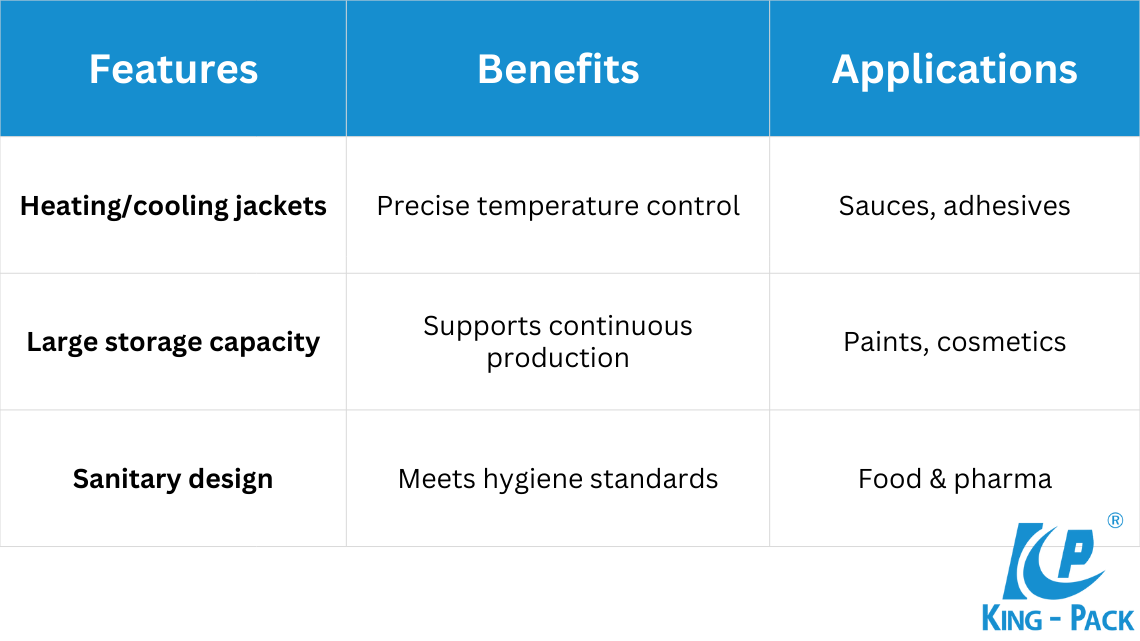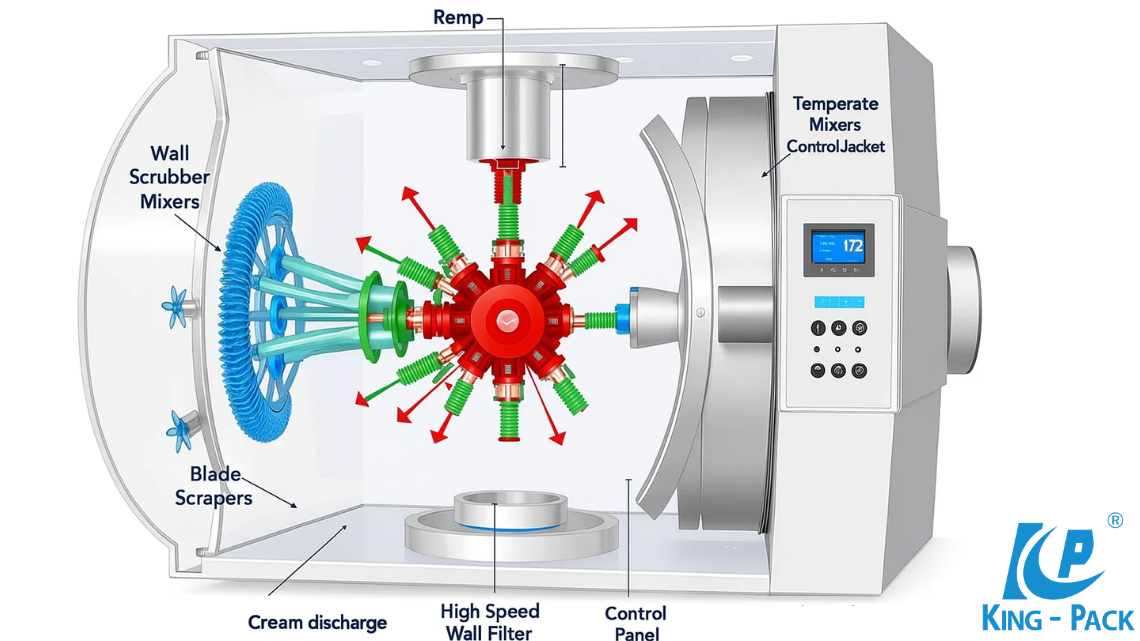Figure: An emulsifying machine from King-Pack
An emulsifying machine is a piece of equipment designed to blend materials that normally don’t mix well. Oil and water, for example, need help to combine into a stable product. That’s where these machines play a role.
The main job of an emulsifier machine is to mix materials. It also works to homogenize them. Another key role is to emulsify liquids that normally don’t blend. The result is a product that feels smooth and stays stable!
Different industries use it in different ways. And in this article, we will discuss that in detail. We’ll break down how the same technology serves very different needs across multiple industries.
Core Functions of an Emulsifying Machine
Mixing & Homogenizing
An emulsifying machine begins with the basic task of mixing. In the mixing tank, solid and liquid ingredients are combined into a single mixture. The next stage is homogenization. Using a high-pressure homogenizer or a vacuum emulsifying mixer, the mixture is exposed to high shear forces that reduce particle size. This step creates a smooth and uniform blend.
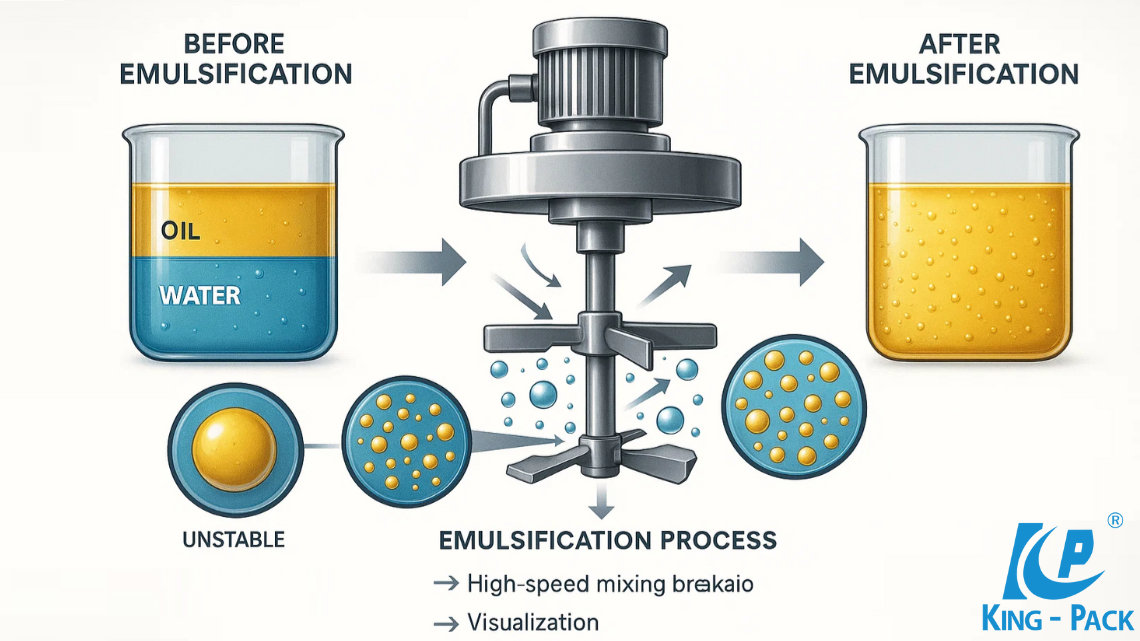
Figure: Core Functions of an Emulsifying Machine
This process is the foundation of stable production in food, cosmetics, and pharmaceuticals. And with King Pack’s emulsifier mixer machine, manufacturers can achieve consistency across every batch, ensuring products meet quality standards.
Check King Pack’s Emulsifier Machines
Emulsification Process Explained
The role of an emulsifier mixer machine goes beyond simple mixing. It creates stable emulsions by breaking down oil into microscopic droplets and dispersing them evenly in water. This transforms mixtures that would normally separate into long-lasting, stable products.
- Keeps oil and water blends stable over time
- Creates creams and lotions with rich, uniform textures
- Enhances flavor and smoothness in food products
By using King Pack’s emulsifier homogenizer machine, companies can control droplet size and achieve superior stability. This is why emulsification is central to cosmetics, pharmaceuticals, and food industries.
Vacuum Function and Its Advantages
Many systems come with a vacuum option. A vacuum emulsifying machine or vacuum emulsifying mixer machine removes air bubbles during production. This prevents oxidation and improves product quality. For cosmetics and pharmaceuticals, it also makes products smoother and more appealing.
Types of Emulsifying Machines
1. Vacuum Emulsifying Machine / Vacuum Emulsifying Mixer Machine
A vacuum emulsifying mixer machine is ideal for high-viscosity materials such as creams, gels, and pharmaceutical ointments. Its vacuum system removes trapped air, producing denser, smoother products. This makes it a top choice in cosmetics manufacturing and the pharmaceutical industry.
The machine combines multiple steps—mixing tank blending, homogenizing head action, heating, and vacuum deaeration—into one unit. This design reduces production costs, saves time, and improves batch consistency. Automated control systems allow manufacturers to adjust speed, shear energy, temperature, and pressure to fit different formulas.
For manufacturers, emulsifying mixer machines offer flexibility and precision. They support small laboratory batches as well as large-scale industrial production.
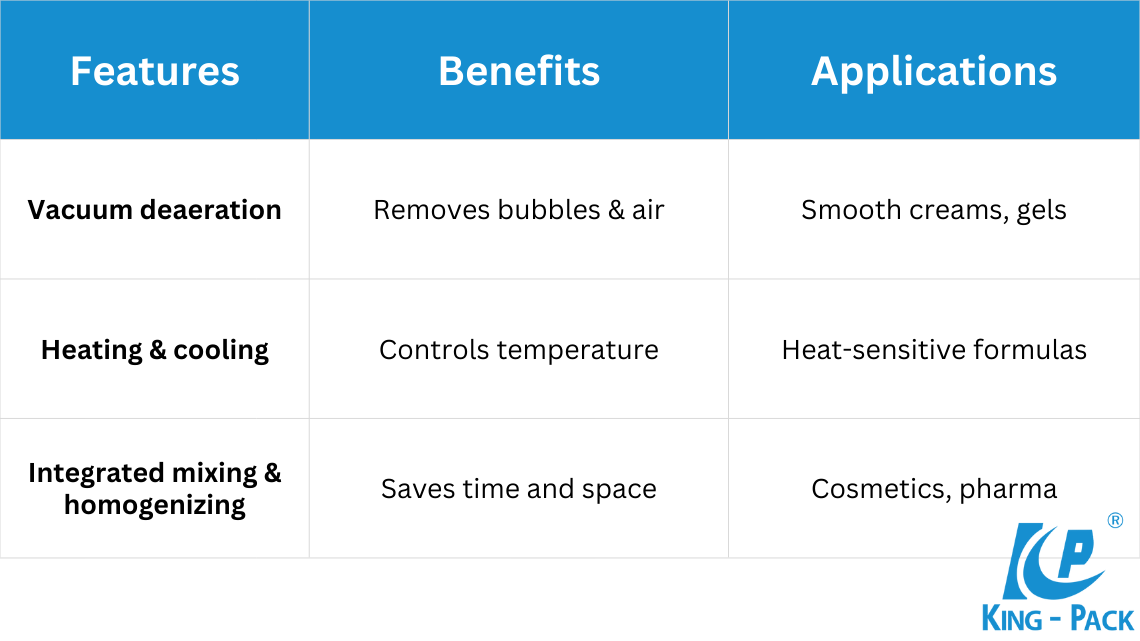
2. High Pressure Homogeniser and Emulsifier Homogenizer Machine
A high pressure homogeniser uses powerful force to push liquids through a narrow valve at high speed. This action breaks particles into extremely fine sizes, creating highly stable emulsions. It’s often chosen for products that demand smooth textures and long shelf life.
The homogenizer emulsifier machine combines homogenization with mixing, making it suitable for syrups, sauces, dairy, and emulsions. King Pack’s emulsifier homogenizer machine is built for precision, offering reliable performance in both food and pharmaceutical production.
With this machine, manufacturers can achieve particle sizes down to the micron level. This level of refinement improves product stability, taste, and absorption. For industries like food and pharma, where consistency matters, a high pressure homogeniser is invaluable.
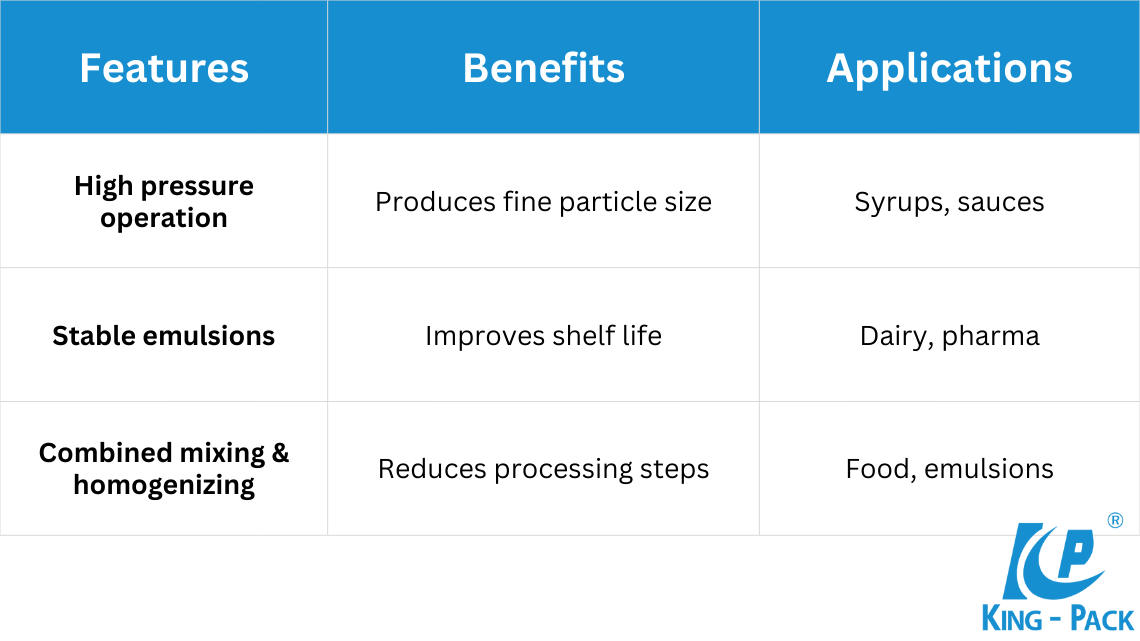
3. Heated Mixing Tank and Mix Tanks
Some materials require controlled heating during blending. A heated mixing tank uses built-in jackets to warm or cool ingredients as needed. This helps melt raw materials like waxes or dissolve powders before mixing begins.
Large mix tanks play an important role in continuous production. They store, blend, and prepare batches for the next processing stage. King Pack offers heated mixing tanks and mix tanks that are designed with temperature control and sanitary standards in mind.
These tanks are highly versatile. They’re used in sauces, adhesives, paints, and other formulations where heating or cooling is essential. For food and chemical industries, they ensure smooth production without interruptions.
4. Specialized Emulsifier Machines for Cosmetics, Pharmaceuticals, and Food
Every industry has specific requirements. An emulsifier machine for cosmetics is designed to handle delicate formulas like creams, lotions, and shampoos. It provides stable emulsions with a smooth finish, which is essential for skincare and personal care products.
A pharmaceutical mixer must follow GMP rules and guarantee sterile production. King Pack’s pharmaceutical mixer is built with clean design, CIP systems, and precise controls to handle syrups, ointments, and medical emulsions safely.
The food emulsifier machine is engineered for sauces, mayonnaise, dairy, and beverages. King Pack’s food emulsifier machine allows consistent flavor, smooth textures, and stable emulsions even in large-scale production. Each machine is adjusted to match the unique needs of its industry.
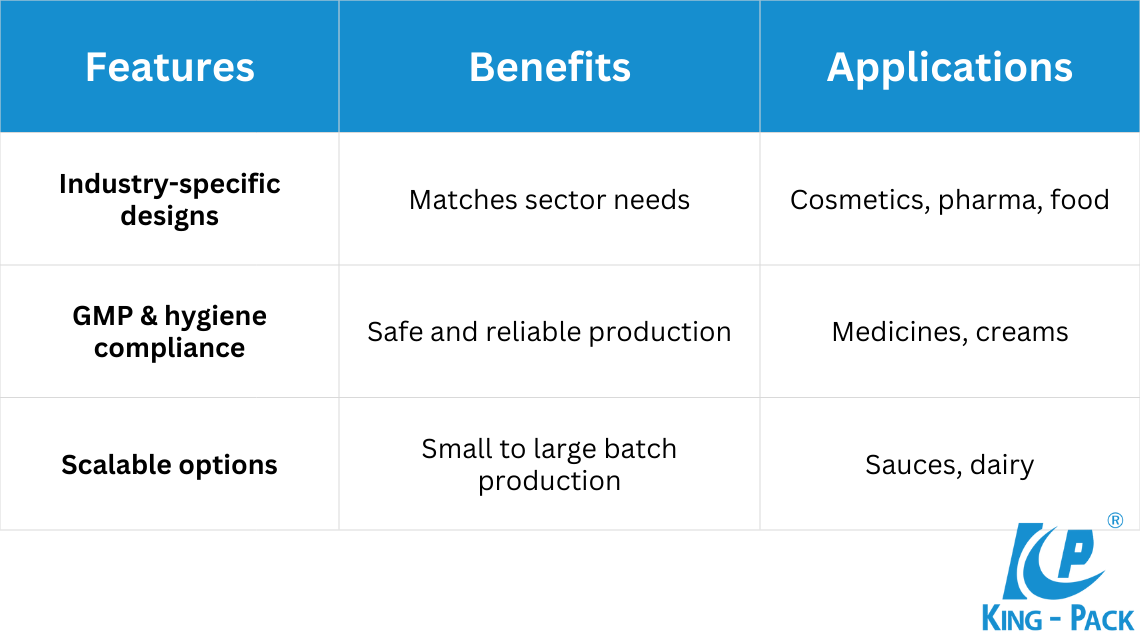
Key Components and Working Principle
A vacuum emulsifying mixer or emulsifying machine is made up of several components that work together to produce stable, smooth mixtures. Each part contributes to product quality, and their interaction determines the consistency and shelf life of the final batch.
Scrapers move along the wall of the mixing tank, preventing materials from sticking or burning. This ensures even heat distribution and full incorporation of ingredients. Scrapers are especially important for high-viscosity products like pharmaceutical ointments, creams, gels, or sticky food items.
Agitators circulate materials inside the tank, pushing contents from top to bottom and side to side to eliminate dead zones. Strong agitators are essential for uniformity in viscous formulations, including adhesives, toothpaste, and lotions.
High-shear mixers or high-pressure homogenizers break particles into extremely fine droplet sizes, creating a stable emulsion. By applying high shear forces, oil and water phases disperse evenly, improving texture, stability, and absorption. Without high-shear rotor-stator mixers or homogenizing turbines, emulsions would separate quickly.
Many emulsifying systems include jacketed mix tanks, which allow heating or cooling during processing. Waxes or fats may require melting, while dairy products may need cooling to preserve freshness. Accurate temperature regulation is critical for product quality and extending shelf life.
Modern machines often feature automated control systems. Operators can adjust speed, temperature, and vacuum pressure with precision, and some systems store recipes for repeatable production. This reduces human error and allows scaling from laboratory-scale mixers to large-scale manufacturing.
The working principle of a vacuum emulsifying mixer machine is straightforward: raw materials enter the tank, scrapers prevent sticking, agitators circulate, high-speed mixers or homogenizers reduce particle size, jacketed tanks regulate temperature, and automated PLC automatic control ensures consistency. The result is a smooth, uniform, and high-quality product ready for filling and packaging.
Applications of Emulsifying Machines
1. Cosmetic
Cosmetic products like creams, lotions, gels, and shampoos need stable emulsifiers to maintain smooth texture and long shelf life. An emulsifier homogenizer machine blends oil and water phases evenly, preventing separation and keeping products consistent and easy to apply.
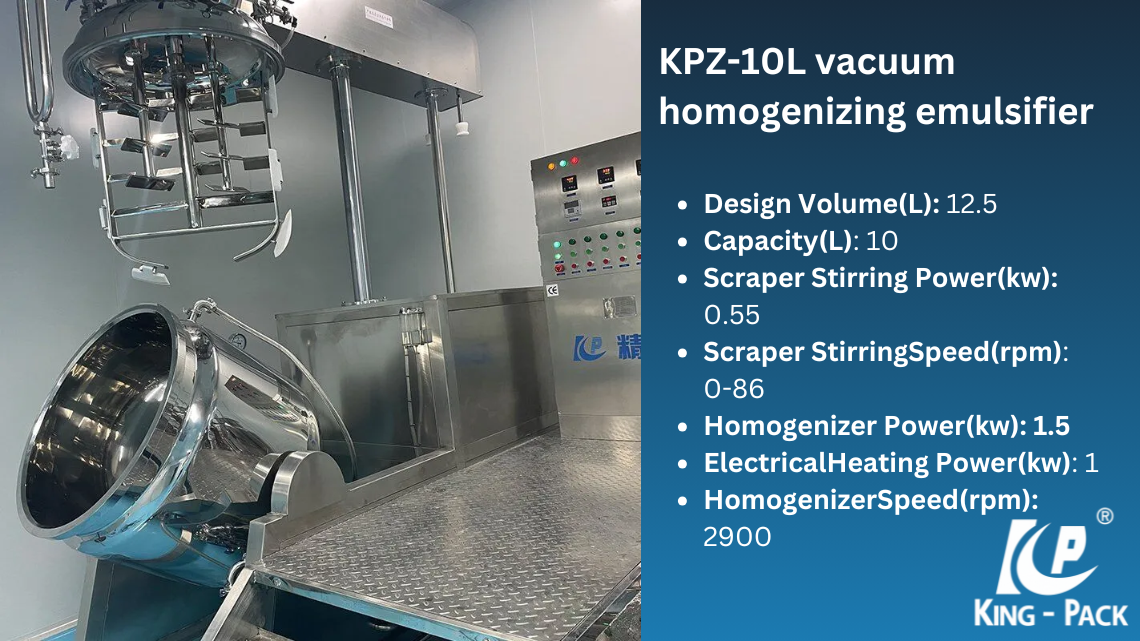
The King Pack KPZ-10L Vacuum Homogenizing Emulsifier is designed for small-scale cosmetic production and lab use. It combines vacuum deaeration, heating, and high-shear mixing to create silky creams and bubble-free gels that meet industry standards.
- Produces stable emulsions for creams, lotions, and gels
- Removes trapped air for smooth, glossy finishes
- Ideal for R&D labs and small-batch manufacturing
With the KPZ-10L, cosmetic brands can test new formulas and scale up confidently, while ensuring product quality and shelf appeal.
2. Pharmaceuticals
Pharmaceutical production requires sterile and precise mixing conditions. Products such as ointments, syrups, and emulsions rely on accurate particle dispersion to maintain stability and correct dosage. A pharmaceutical emulsifier machine makes this possible by delivering controlled homogenization for sensitive drug formulations.
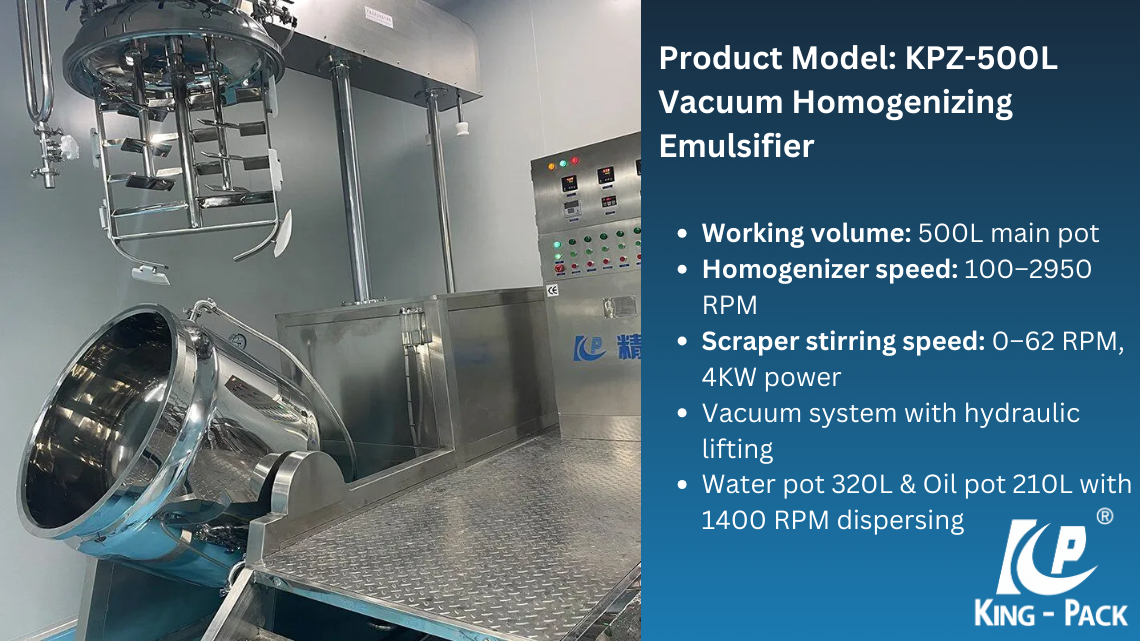
King Pack’s KPZ-500L Vacuum Homogenizing Emulsifier is designed for pharmaceutical use. It handles high-viscosity products like creams and ointments, while its vacuum system removes air bubbles to guarantee consistency. With features that support GMP compliance, it ensures safe preparation of syrups, suspensions, and emulsions.
- Maintains sterile processing with vacuum technology
- Provides precise homogenization for stable pharmaceutical products
- Suitable for ointments, syrups, suspensions, and emulsions
By integrating King Pack emulsifiers into pharmaceutical production, companies can achieve consistent quality, improve shelf life, and meet strict regulatory standards.
4. Food
In food production, texture, flavor, and stability all depend on proper emulsification. Sauces, mayonnaise, dairy, and dressings must stay uniform without separating. A food emulsifier machine creates smooth and stable products while improving shelf life.
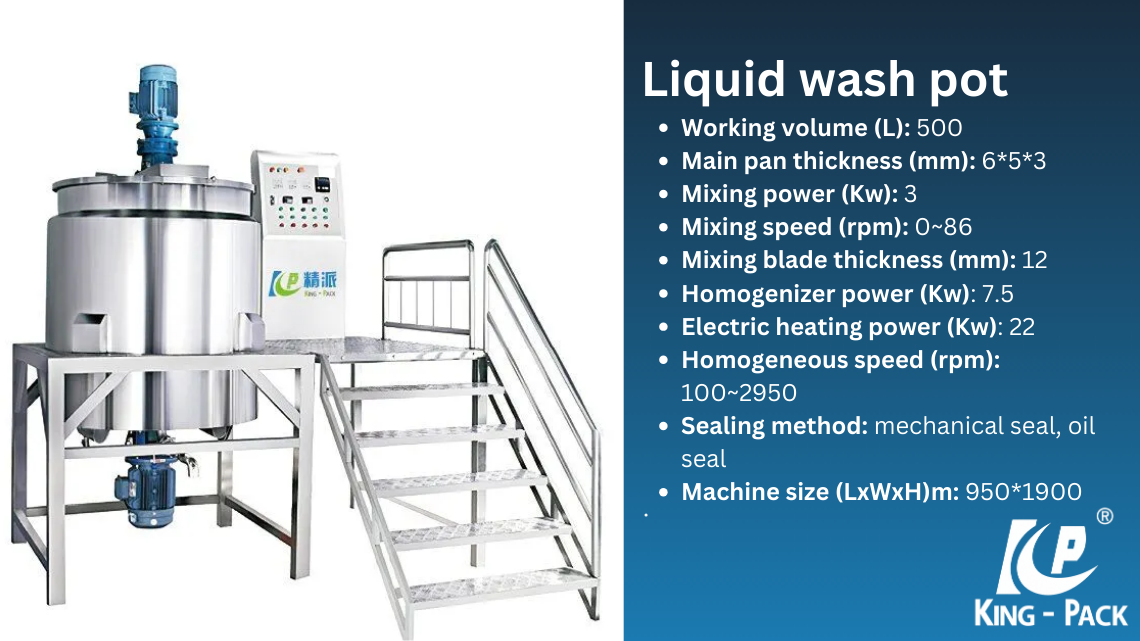
King Pack supports food processors with the Liquid wash pot, which works alongside emulsifying equipment to prepare and clean liquid ingredients before blending. This ensures hygiene while maintaining flavor and consistency in food production.
- Keeps sauces and dressings smooth and uniform
- Enhances creaminess in dairy-based products
- Supports hygienic large-scale production
With the right equipment, food producers can deliver high-quality products that maintain stability during storage and transport.
5. Chemicals
The chemical industry needs powerful chemical mixing equipment for adhesives, paints, and coatings. These products often have high viscosity and demand heating, cooling, and vacuum processing to achieve reliable performance.
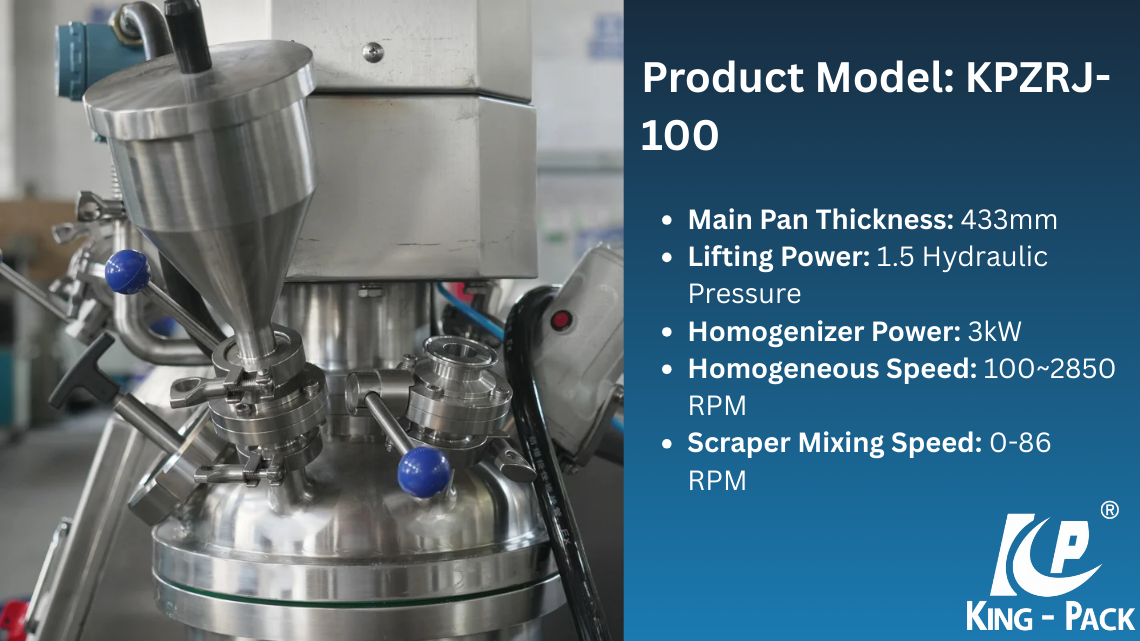
King Pack’s KPZ-100L vacuum emulsifying machine is built for this purpose. It combines vacuum technology with strong homogenization, allowing adhesives and coatings to reach a stable, uniform state. This makes it easier to handle viscous formulas while maintaining quality and consistency.
- Mixes and processes paints, adhesives, and coatings
- Handles high-viscosity chemical products with vacuum technology
- Delivers uniform and stable emulsions for industrial applications
- Supports heating and cooling for precise processing
- Improves durability and performance of finished products
By using specialized emulsifying machines like the KPZ-100L, manufacturers can achieve consistent production standards while meeting the demands of industrial-grade formulations.
How to Choose the Right Emulsifying Machine
When selecting, consider material viscosity, batch size, and the level of automation needed. Some businesses need small mix tanks. Others need large vacuum emulsifying machines for mass production.
The qualifications of the emulsifier machine manufacturer also matter. Look for hygienic design, GMP compliance, and proven reliability.
For trade, you’ll also need to know the emulsifier machine HS code. This helps with import and export classification.
Maintenance and Best Practices
Keeping an emulsifying machine in good condition is vital for reliable performance. Regular cleaning, inspections, and timely adjustments prevent downtime and help the machine deliver stable results batch after batch.
- Cleaning in Place (CIP): Many emulsifier machines support CIP systems, allowing fast and hygienic cleaning without dismantling.
- Seal and Gasket Checks: Inspect seals regularly to avoid leaks that could affect vacuum pressure or contaminate the product.
- Blade and Agitator Care: Monitor wear and alignment to keep mixing consistent and efficient.
- Temperature and Pressure Controls: Verify accuracy to maintain correct processing conditions.
- Adjustments for Issues: Solve problems like product separation by fine-tuning mixing speed or vacuum levels.
Following these practices extends the lifespan of the equipment and keeps production steady. King Pack’s KPZ vacuum emulsifying mixer is designed with easy cleaning access and reliable controls, making routine maintenance simpler while supporting high-quality output in every industry.
Conclusion
An emulsifying machine is at the heart of smooth, stable, and high-quality production. From cosmetics and pharmaceuticals to food and chemicals, it ensures every product batch meets the standards your customers expect. Choosing the right machine—whether it’s a vacuum emulsifying mixer machine or a high pressure homogenizer—directly impacts product consistency, efficiency, and shelf life.
King Pack offers a complete range of emulsifying machines, including the KPZ vacuum emulsifying mixer series, built for performance, reliability, and easy maintenance. Backed by advanced technology and strong industry experience, King Pack delivers solutions that help businesses scale faster and stay competitive.
If you’re ready to upgrade your production line with reliable emulsifying equipment, contact King Pack today and get the right machine tailored to your needs.
Meta Description: Learn what an emulsifying machine does—mixing, homogenizing, and emulsifying in cosmetics, pharmaceuticals, food, and chemical industries using advanced vacuum emulsifying technology.



